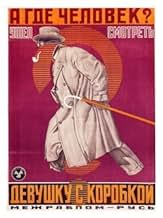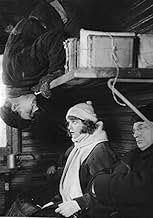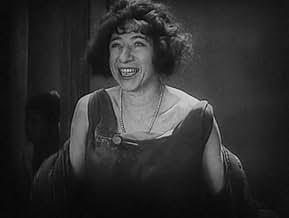अपनी भाषा में प्लॉट जोड़ेंNatasha and her grandfather live in a cottage near Moscow, making hats for Madame Irène. Madame and her husband have told the housing committee that Natasha rents a room from them; this fidd... सभी पढ़ेंNatasha and her grandfather live in a cottage near Moscow, making hats for Madame Irène. Madame and her husband have told the housing committee that Natasha rents a room from them; this fiddle gives Madame's lazy husband a room for lounging. The local railroad clerk, Fogelev, lov... सभी पढ़ेंNatasha and her grandfather live in a cottage near Moscow, making hats for Madame Irène. Madame and her husband have told the housing committee that Natasha rents a room from them; this fiddle gives Madame's lazy husband a room for lounging. The local railroad clerk, Fogelev, loves Natasha but she takes a shine to Ilya, a clumsy student who sleeps in the train station... सभी पढ़ें
- निर्देशक
- लेखक
- स्टार
फ़ीचर्ड समीक्षाएं
The story and the characters were extremely charming. Anna Sten was beautiful. The baddies were more comical than they were truly evil. And everything turns out happily in the end. It could have almost been a Hollywood movie, except the photography is better.
I'd like to see more Russian comedies.
9/10
For me, nearly any old film needs to be considered this way, and many from cultures other than mine, though these are rare these days.
This is a slight comedy of the type Hollywood would patent as screwball, but with the heavy dose of physical humor popular in silents. It was made in the Stalinist "union," for a contemporary audience. So you'll see Soviet commissars and effects of contemporary rules. Certain alien stereotypes, including Russian Jews from a Russian perspective.
What's common here with my world is a pretty girl, lust and greed, the stuff of a universal dynamo. But these are cast off kilter from the way you normally see them, so they seem fresh. It helps that the production values are very high, better it seems that your typical American or French film of the era.
Its light, but its placement makes it profound.
Ted's Evaluation -- 3 of 3: Worth watching.
Anna Sten stars in the lead. Does that name ring any bells? Well, I didn't recognize the name, but I clicked on it and read up on her. Apparently Samuel Goldwyn brought her over to the United States (surely based on her performance in Hat Box) to be the next Garbo in the early 1930s. She starred in Nana (Dorothy Arzner & George Fitzmaurice, 1934), We Live Again (Rouben Mamoulien, 1934; also starring Frederic March), and The Wedding Night (King Vidor, 1935, and she starred opposite Gary Cooper). All were enormous bombs, each more astronomical than the last. Afterwards, she appeared in several more Hollywood films in secondary roles. I really, really want to see any of her Hollywood films to see what her problem was. You'd never know there was one from The Girl with the Hat Box. She's gorgeous, charming, and very funny.
The male lead is played, also delightfully, by Ivan Koval-Samborsky, who had a major role in 1926's Mother by Pudovkin. He plays a homeless student whom Sten at first pities and tries to help, but they soon find love in each other. The villains in the film are played by Serafima Birman and P. Paul. They are both exceptional. The latter doesn't seem to have any other film credits, but the former later played Efrosinia, Ivan the Terrible's aunt in Eisenstein's Ivan the Terrible movies. I didn't recognize her, as this was 18 years earlier. Plus, in Ivan she is always covered in huge robes. But you can recognize her from the nose.
The story is pleasantly offbeat, while never seeming forced. It's also quite interesting to see the portrayal of daily life in the USSR of the 1920's. Some of the bureaucratic encumbrances of the early Soviet era are used as plot devices, and it's noteworthy that the bureaucrats and their regulations are not depicted as frightening menaces, but as mere tools that the main characters use for their own purposes. At least a part of the movie's charm comes from the chance to get this kind of good-natured look at the era.
While it's primarily meant as light entertainment, it works very well as such. It's well worth the time to see.
Take this for example. Reviewers have it noted as an early riff on screwball comedy plus slapstick sweetness from Chaplin, with no bearing whatsoever to Eisenstein and the likes, nary an outspoken prole or montage in sight.
Then note again a much more subtle class conflict than anyone else from Kuleshov's film workshop at VGIK envisioned. Two adjacent rooms in the same house, one leased by the well-to-do couple who own the house to a poor girl from the countryside selling hats, who in turn agrees out of pity to be the mock wife to an itinerant bum just to shelter him from the cold. Money drives the world. A feudal relationship exists in essence between the two rooms. The girl is busy working on hats, while the couple mooch off her efforts because they have a place to sell. Authorities come knocking on the door, tax-collectors, the house committee, and are met with cunning wit and deception.
The main gag in the finale is that the husband of the couple bought the lottery ticket standing to win a small fortune but has given it to the hatbox girl.
The scene where he finds out is marvellously rendered as visual radio, with the listener tuning into different excerpts of films. These days he would be shown watching TV. A similar - more sophisticated - scene exists in L'Herbier's superb L'Inhumaine from 1924. My guess is the film was studied at VGIK.
The other reason I've been delving into these films, is for a window in time that sharpens perception. Because silent film portrays a world a little damp and sunless after centuries of cinematic prehistory, caught suddenly in the light of the camera, and really seen for the first time as it prepares to lunge forward from the precipice, so both antiquated and modern at the same time, you get the strange effect of reality in the process. My pet project with these is to see not old times feted in history then, but a modern, contemporary world out the window. Here, it's Moscow as was not often depicted by the Soviets, not completely gloomy and downtrodden, or caught in revolutionary frenzy. Some life going on basically. Also very precious in this regard are Vertov's Kino-Pravda reels.
One more reason to see this is for the brief experiment with synchronous sound.
क्या आपको पता है
- कनेक्शनFeatured in Komediya davno minuvshikh dney (1980)
टॉप पसंद
विवरण
- रिलीज़ की तारीख़
- कंट्री ऑफ़ ओरिजिन
- भाषा
- इस रूप में भी जाना जाता है
- The Girl with the Hat Box
- उत्पादन कंपनी
- IMDbPro पर और कंपनी क्रेडिट देखें
- चलने की अवधि
- 1 घं(60 min)
- ध्वनि मिश्रण
- पक्ष अनुपात
- 1.33 : 1


























